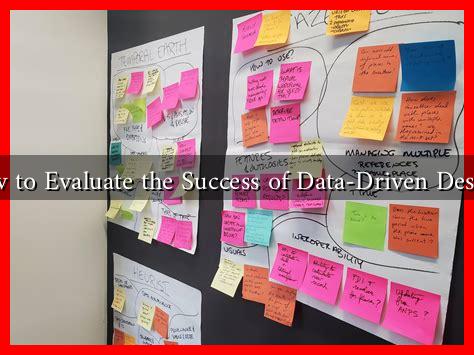-
Table of Contents
How to Evaluate the Success of Data-Driven Design?
In today’s digital landscape, data-driven design has emerged as a pivotal approach for creating user-centric products and services. By leveraging data analytics, designers can make informed decisions that enhance user experience and drive business outcomes. However, evaluating the success of data-driven design is crucial to ensure that the strategies employed are effective and yield the desired results. This article explores various methods and metrics to assess the success of data-driven design.
Understanding Data-Driven Design
Data-driven design refers to the practice of using data analytics to inform design decisions. This approach allows designers to understand user behavior, preferences, and pain points, leading to more effective and engaging designs. The success of data-driven design can be evaluated through various metrics and methodologies.
Key Metrics for Evaluation
To effectively evaluate the success of data-driven design, it is essential to focus on specific metrics that align with business goals and user experience. Here are some key metrics to consider:
- User Engagement: Measure how users interact with your design through metrics such as time spent on page, click-through rates, and bounce rates.
- Conversion Rates: Track the percentage of users who complete a desired action, such as signing up for a newsletter or making a purchase.
- User Satisfaction: Utilize surveys and feedback forms to gauge user satisfaction and gather qualitative data on their experiences.
- Retention Rates: Analyze how many users return to your product or service over a specific period, indicating the design’s effectiveness in retaining users.
- Task Success Rate: Measure the percentage of users who successfully complete a task within the design, reflecting usability and effectiveness.
Methods for Evaluation
In addition to metrics, various methods can be employed to evaluate the success of data-driven design:
- A/B Testing: This method involves comparing two versions of a design to determine which one performs better based on user interactions and conversions. For example, a company might test two different landing pages to see which one leads to more sign-ups.
- User Testing: Conduct usability tests with real users to observe their interactions with the design. This qualitative data can provide insights into areas for improvement.
- Analytics Tools: Utilize tools like Google Analytics, Hotjar, or Mixpanel to track user behavior and gather data on how users interact with your design.
- Heatmaps: Use heatmaps to visualize where users click, scroll, and spend the most time on your design. This can help identify areas that are engaging or confusing.
Case Studies and Examples
Several companies have successfully implemented data-driven design and evaluated its success:
- Airbnb: By analyzing user data, Airbnb redesigned its search interface, resulting in a 30% increase in bookings. They used A/B testing to refine their design based on user interactions.
- Netflix: Netflix employs data analytics to personalize user experiences. By evaluating user engagement metrics, they continuously refine their recommendation algorithms, leading to higher user satisfaction and retention rates.
Challenges in Evaluation
While evaluating the success of data-driven design is essential, it is not without challenges. Some common obstacles include:
- Data Overload: With vast amounts of data available, it can be challenging to identify which metrics are most relevant to your goals.
- Misinterpretation of Data: Without proper analysis, data can be misinterpreted, leading to misguided design decisions.
- Changing User Behavior: User preferences and behaviors can change over time, making it necessary to continuously evaluate and adapt designs.
Conclusion
Evaluating the success of data-driven design is a multifaceted process that requires a combination of metrics, methods, and continuous adaptation. By focusing on key performance indicators such as user engagement, conversion rates, and user satisfaction, designers can gain valuable insights into the effectiveness of their designs. Employing methods like A/B testing and user testing can further enhance the evaluation process. As demonstrated by successful companies like Airbnb and Netflix, leveraging data analytics can lead to significant improvements in user experience and business outcomes. Ultimately, a commitment to ongoing evaluation and adaptation is essential for achieving long-term success in data-driven design.
For more insights on data-driven design, consider exploring resources from Smashing Magazine or Nielsen Norman Group.

